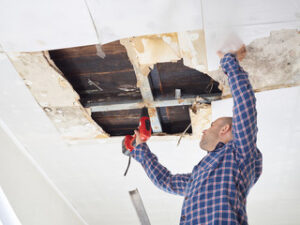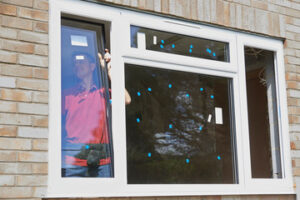The appearance of cracks or water stains on a ceiling should be addressed immediately. They are often indicators of underlying problems such as structural issues or burst pipes.

For minor repairs, homeowners can use caulk or lightweight spackle. For larger areas, drywall mud or joint compound is best. It’s important to keep the work area well-ventilated and wear a dust mask. For professional help, contact Ceiling Repair Perth.
Over time, virtually all homes will develop cracks in their ceilings. While many are cosmetic, others can indicate more serious structural damage that requires prompt repairs. In some cases, examining the shape, size, and location of a crack can help homeowners figure out the cause and decide what to do next.
Fine hairline cracks around the edges of a ceiling are usually a sign of normal settling. However, if they are in the middle of a room, or across multiple areas of a ceiling, they could be an indication of more significant problems. Cracks that widen and lengthen over time are a good indicator of moisture damage to the ceiling, often from a leaky roof or plumbing. In this case, it is critical to find the source of the water and make necessary repairs before they become worse.
Another common reason for cracks in a ceiling is due to seasonal changes in humidity, temperature, and moisture content. This can cause the wood joists that hold up the ceiling to expand and contract. This can lead to a separation between the ceiling and wall, or even the floor above.
Cracks in a ceiling can also be caused by poor workmanship during the construction process, especially if the drywall was not taped properly. It can also be the result of insufficient framing, or a combination of these issues.
When a homeowner notices a crack in their ceiling, they should call for professional help right away. These professionals will know how to spot the cause and repair it correctly, and will use the proper materials for safe and lasting results. They will be able to spot other potential issues, such as water leaks and structural damage, so they can be addressed before the problem gets worse. They will also be able to determine the correct texture and paint for the ceiling to give it an attractive finish that blends with the rest of the room. Using a professional is much safer and more cost effective than trying to fix the issue on your own, which can be dangerous.
Water Stains
When water stains appear on the ceiling, they are more than just an eyesore. They are a warning that water damage is happening elsewhere in the home and needs to be addressed before it worsens. Depending on what caused the stain, water stains can indicate roof problems, plumbing issues, or even high moisture levels in attics.
Water stains are most commonly caused by leaks, especially when the stained area is close to a sink or toilet. If this is the case, shut off your home’s water supply and call a plumber immediately to investigate and fix the problem. The best way to prevent water stains from appearing is to implement routine maintenance on your roof and plumbing system. In addition, installing dehumidifiers in areas where condensation forms can help reduce the risk of unsightly marks on your ceiling.
It is possible to get rid of water stains on your ceilings by cleaning the affected area and repainting. However, it is important to note that covering up water stains with a fresh coat of paint will not address the underlying cause of the stain. To ensure that your ceilings are safe for painting, you will need to thoroughly clean the stained area first. This will involve mixing a solution of one part bleach to three parts warm water or using a premixed bleach solvent and scrubbing the stain with a sponge.
Once the water stains have been cleaned, you will need to apply a stain – blocking primer to the affected area and allow it to dry completely. Then you can apply a new coat of ceiling paint. Make sure to choose a color that will blend in with the rest of your ceilings so it doesn’t stand out.
If the water stains on your ceiling are extensive, or you suspect there may be structural damage to the ceiling or walls beneath them, you should contact a professional roofer, drywall installer, or handyman. They will be able to inspect the affected area and provide you with a quote for repair costs. They can also assist you in finding the source of the water stains, which may require the removal and replacement of portions of your home’s ceiling.
Wood Rot
Wood rot is a common issue in many homes. It can be caused by a variety of factors, such as a leaky roof or poorly ventilated rooms. If the fungus is not treated, it can spread quickly and damage the wood that supports your home’s structure. If it gets into the wall studs, it can compromise the integrity of your home’s foundation and lead to serious structural issues. In addition, the fungus can release spores that can trigger respiratory problems in people with sensitive allergies.
The best way to treat wood rot depends on the extent of the damage. If caught in the early stages, a borate solution can kill off the fungus and prevent it from spreading. However, it may be necessary to remove the rotting section of timber and replace it with fresh wood. This will ensure that the problem is eradicated at the source and prevent it from recurring.
Wet wood rot is more difficult to detect than dry rot. It is sometimes confused with normal discoloration and growths. A professional can identify wet rot by the color of the affected wood and by the way it feels to the touch. The fungus usually produces a foul smell.
Repairing or replacing rotted wood is usually a straightforward process. The wood needs to be thoroughly cleaned and prepared before the epoxy filler can bond effectively with it.
Start by removing any loose sections of wood with a claw hammer or saw. Then scrape and chisel away the damaged areas until you reach the healthy wood underneath.
Apply a liquid epoxy filler to the area once the rot has been removed. Follow the manufacturer’s instructions to ensure that the filler is applied correctly and dries for the recommended time. Once it has dried, sand the repaired area until it is smooth and blends with the surrounding wood. Finally, paint the repaired area using a high-quality waterproof product to protect it from further damage.
It is important to replace or repair any rotted wood before attempting to sell your home. Visible rot can be a major turn-off for buyers and can raise concerns about other deferred maintenance. It is also a fire hazard and a potential breeding ground for insects.
Structural Issues
Structural issues are a landlord or property manager’s worst nightmare, as they not only damage the value of your building, but they also pose potential health and safety hazards for current residents. Fortunately, these problems are usually easy to spot and are not too difficult to repair.
Cracks in the ceiling are one of the most common signs that a problem is occurring. Hairline cracks are usually harmless and purely cosmetic, but large cracks that extend down a wall or are accompanied by sagging indicate more serious structural problems.
These cracks are often caused by moisture or movement in the ceiling. If the cracks are wide, it is likely that the lath system beneath the plaster is failing and needs to be replaced. If you notice these types of cracks, a professional should be called in to examine the area and determine the best course of action.
Another sign of a ceiling issue is sagging drywall. This is a major problem that can lead to severe water damage and other issues, so it is important to call a professional right away. In some cases, sagging may be due to heavyweight from an object on the floor above or incorrect removal of a load-bearing wall.
Many different problems can cause damage to a ceiling, so it is important to keep an eye out for any signs of damage and address them immediately. It is also a good idea to have a monthly inspection of the ceilings in order to catch any problems as they develop, and to prevent them from getting out of hand.
Structural issues in a building are always a concern and need to be addressed right away. They can be a result of natural settling in older structures, poor workmanship or even environmental conditions. It is often easier to identify these issues with regular inspections than it is to notice the subtle signs that they are present. It is also worth noting that any type of structural damage to a ceiling should be examined by a professional right away in order to prevent further damage and save you money down the road.



